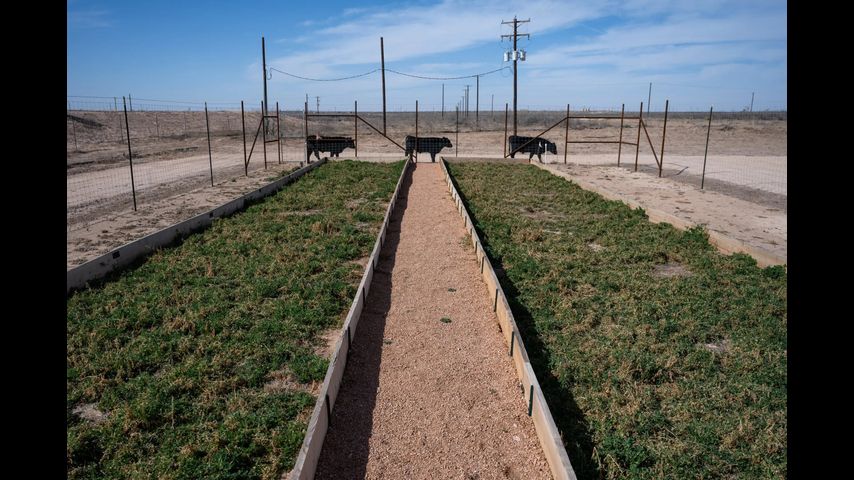Can Texas clean up fracking water enough to use for farming? One company thinks so.
"Can Texas clean up fracking water enough to use for farming? One company thinks so." was first published by The Texas Tribune, a nonprofit, nonpartisan media organization that informs Texans — and engages with them — about public policy, politics, government and statewide issues.
Subscribe to The Y’all — a weekly dispatch about the people, places and policies defining Texas, produced by Texas Tribune journalists living in communities across the state.
This article is part of Running Out, an occasional series about Texas’ water crisis. Read more stories about the threats facing Texas’ water supply here.
MIDLAND — On any given day, energy companies across the vast Permian Basin in West Texas inject millions of gallons of water into the dry brown earth, breaking up layers of rock on the hunt for crude oil.
As oil and gas are extracted, water flows back up. It is all but unusable — unless treated.
Often referred to as produced water, the grimy backwash is full of dirt, minerals and hundreds of chemicals, some of which can be radioactive. Companies must dispose of it somehow. Most, with state permission, inject it underground. Increasingly, oil producers are cleaning it up just enough to reuse it for more fracking.
Now, amid a growing water crisis, there is interest in oil country — and Austin — to clean the water further for agriculture and other industries.
Texas Pacific Water Resources is one company leading the effort. The West Texas company says it has developed methods to clean the water sufficiently to be released into bodies of water that can be used by farmers. And it’s seeking state permission to expand its operation, with the hope of sending millions of gallons up the Pecos River to parched farm land.
[Texas is running out of water. Here’s why and what state leaders plan to do about it.]
“We've seen in testing the soil and the crops that no contamination was detected,” Adrienne Lopez, a research manager at Texas Pacific, said. “The soil’s been perfectly healthy, as well as the plants.”
/https://static.texastribune.org/media/files/4bc675f26eaf25b6482312ce8da8c3b4/0214%20Produced%20Water%20EL%2009.jpg)
/https://static.texastribune.org/media/files/fc4c0027787b3937deb401f4c1c18a7d/0214%20Produced%20Water%20EL%2003.jpg)
The state’s water supply is under duress from a growing population, climate change and deteriorating infrastructure. In West Texas, as in much of the state, there is not enough water to meet demand if the state is struck by a 100-year drought, according to state data. The state’s water plan suggests municipal needs, in particular, will grow in this region of the state for decades to come.
And data gathered by the Texas Water Development Board, which monitors the state’s water distribution, estimates the region will need tens of thousands of acre-feet to sustain the multiple industries — especially the power generators.
Because of this, there is much urgency to find new water supply. Lawmakers are debating a package of bills that would inject billions to secure the state's water future. Meanwhile, supporters of cleaning fracking water, however, caution this effort is years away from saving the state from its water crisis.
Laura Capper, founder and CEO of EnergyMakers, an oil and gas consulting firm, who has advised on produced water projects for more than a decade, said that the hundreds of millions of gallons of oil and gas wastewater can be reused. But it is years away from pulling Texas out of its water crisis.
“We're absolutely not moving fast enough,” Capper said. “We could be looking at four or five years from now, even if we were full steam ahead before we got big facilities up and running, that could make a difference in these water shortages.”
Meanwhile, skeptics warn the effort is not a solution at all.
Decisions regarding produced water discharge should not be driven by urgency, said Jennifer Walker, senior director of the Texas Coast and Water Program at the National Wildlife Federation. She said questions remain about how reliable the treatment methods are, whether there is enough energy to sustain them and the costs.
“We need to take our time and be really, really careful about this and build a lot of trust around it if this is the path that we're going to go down,” she said.
Water and fracking
The amount of water that oil and gas companies need to fracture a well can vary.
A federal estimate put it as high as 16 million gallons per well. But Capper said a modern well needs double — up to 34 million gallons. Oil companies rarely use fresh water, instead using brackish or recycled produced water.
The state prohibits oil companies from discharging untreated produced water into lakes and rivers. Instead they must put the resurfaced produced water in a disposal well or reuse it for more fracking.
Those disposal practices harm the environment in other ways. The Texas Railroad Commission established a connection between disposal in deep disposal wells and seismic activity, resulting in regulators limiting how much water that operators can inject underground. Produced water has also burst through abandoned wells at least eight times.
Scientists have studied produced water for at least a decade. And during the last five years, research has accelerated. The Texas Legislature even put up $10 million to help study the practice.
/https://static.texastribune.org/media/files/a280f24b837851197f87c9fb99704936/0214%20Produced%20Water%20EL%2022.jpg)
/https://static.texastribune.org/media/files/ca1da0d15036a693c3de9be2edf9fb75/0214%20Produced%20Water%20EL%2004.jpg)
Inside Texas Pacific Water, rows of pipes line the edges of the floors, walls and ceiling. They’re connected to water tanks inside a chilly, compact room where Lopez and her four-person crew study produced water treatment methods.
The water is hauled from the 7,000 oil fields that make up this region of the state. And it is just a fraction of the millions of gallons of wastewater produced daily by oil and gas.
The Texas Pacific Land Corporation, which owns Texas Pacific Water, was founded in the 19th Century. It is one of the largest landowners in the state. The company inherited the land originally owned by a defunct railroad company. For decades, it has managed leases, royalties and land sales.
The water business launched in 2017. Texas Pacific Water’s main business is to provide water for fracking. It constructs above-ground source water pits, large trenches filled with brackish water. It sells the water to oil companies drilling wells as far as 70 miles, sending it through pipelines to well sites.
And now it is cleaning up that water.
How to clean produced water
With at least 400 contaminants, produced water is a highly complicated and unpredictable liquid to treat. The amount of chemicals in each sample varies, depending on the layer of rock from which the water escapes. It is up to four times saltier than seawater.
Texas Pacific Water gets the water from Midland, Loving and Reeves counties, Lopez said, adding that the chemical properties in each varied, allowing them to study more samples.
Most of the produced water it cleans is returned to its customers. Industry leaders estimate that produced water makes up about half of the water that operators use for fracking, with the rest being mostly brackish water. Few use freshwater, experts said, a practice that is frowned upon in the industry.
The scientists start by oxidizing the water, which kills hydrogen sulfide, or H2S, a colorless, flammable and incredibly toxic gas. Oxidizing the water also scrubs out the oil and converts any iron into a solid particle. H2S, oil and iron are the contaminants that need to be removed from the water to be used for fracking. This step can take a day.
In 2020, they started freezing the water. The method crystallizes the liquid, which forces more impurities out. The temperature at which they freeze the water will depend on its salinity. After freezing, the water is desalinated again.
Lopez and her team began testing treated produced water on native West Texas plants in August of 2023. Inside a makeshift greenhouse, there were yucca, mesquite and agave plants, and grass. With state permission, they began discharging produced water into a controlled tract of land where alfalfa was grown in February 2024.
The soil and plants were tested again for any toxic contaminants. None were detected.
/https://static.texastribune.org/media/files/4dc095402c969f0d9aef073650826c33/0214%20Produced%20Water%20EL%2013.jpg)
/https://static.texastribune.org/media/files/4aec838887fef348a1b5d564445591b2/0214%20Produced%20Water%20EL%2017.jpg)
“The native plants took the water very well,” she said. “The mesquite trees grew almost out of control.”
The Texas Commission on Environmental Quality, which regulates air and water pollution, is evaluating four applications requesting to discharge, or release, produced water into the environment. Texas Pacific Water Resources is one of them.
In a statement, the environmental quality commission said the permits are designed to protect receiving waters and human health, and include monitoring requirements and federally mandated limits on the amount of pollutants that can enter the water. Regulators are also considering information gathered by the Texas Produced Water Consortium, which is conducting similar research in five separate pilot projects.
Dan Muller, an engineer and consultant on produced water projects for over a decade, said the science is not yet there.
“You really cannot rush science,” he said. “I recognize that people are anxious, but we've got to make sure as data is generated, there's good scientific review and frank conversations around that data, what it tells us, what it doesn't tell us, and what the next step is.”
Texas Pacific Water Resources is bullish about its method.
Robert Crain, executive vice president of Texas Pacific Water Resources, said the goal was to prove the water can be cleaned and regulated enough and released into other bodies of water that farmers can use.
“I think the amount of work that we and one or two other companies have put in has been there to quell the fears in a completely scientific way and say, ‘Look, this is safe water,’” Crain said.
Tickets are on sale now for the 15th annual Texas Tribune Festival, Texas’ breakout ideas and politics event happening Nov. 13–15 in downtown Austin. Get tickets before May 1 and save big! TribFest 2025 is presented by JPMorganChase.
This article originally appeared in The Texas Tribune at https://www.texastribune.org/2025/05/01/texas-water-crisis-oil-gas-fracking-farming/.
The Texas Tribune is a member-supported, nonpartisan newsroom informing and engaging Texans on state politics and policy. Learn more at texastribune.org.





